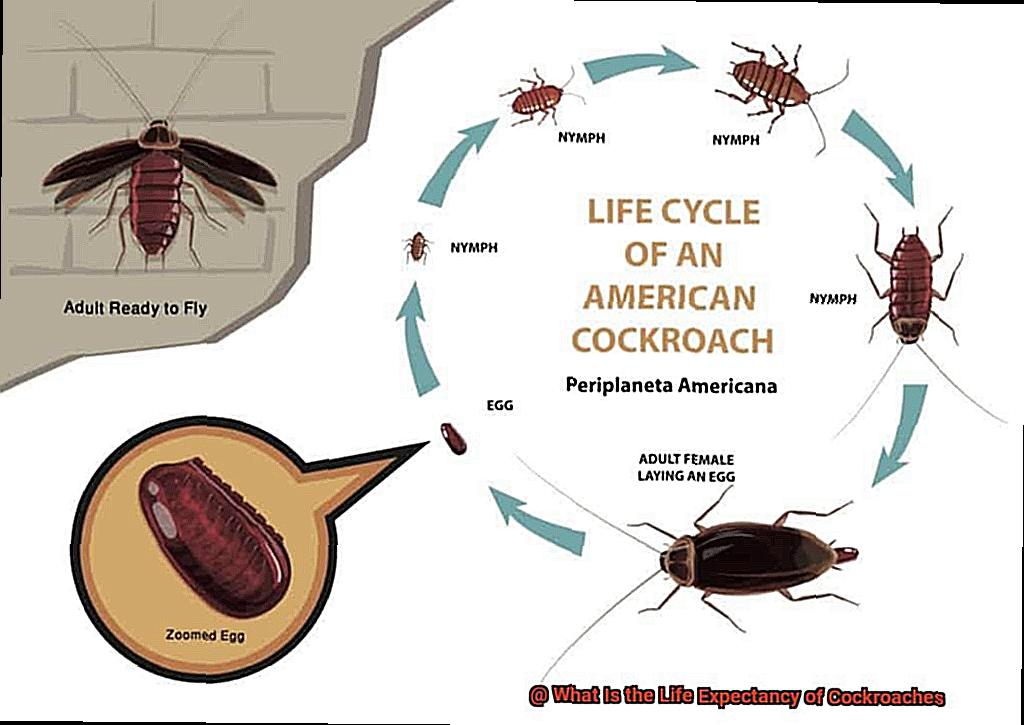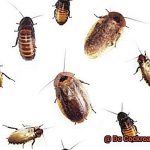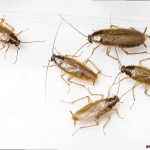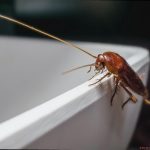Cockroaches are the ultimate survivors.
These resilient pests have been around for over 350 million years, and they show no signs of disappearing anytime soon. They can adapt to almost any environment, reproduce at an alarming rate, and thrive in even the filthiest of conditions.
But how long do these pesky insects actually live? It’s a question that has piqued the curiosity of entomologists and homeowners alike.
After all, if you’re dealing with a cockroach infestation in your home, you want to know how long you’ll have to put up with them. On average, a cockroach can live up to a year.
Of course, this lifespan can vary depending on factors such as species and environmental conditions. But even a year is a long time when it comes to dealing with these unwelcome guests.
So, what can you do to prevent and eliminate cockroach infestations? First of all, it’s important to act fast.
Cockroaches reproduce quickly, so the longer you wait to address the problem, the worse it will become. In this post, we’ll explore some of the factors that can affect the lifespan of cockroaches and provide tips on how to keep them out of your home for good.
From sealing cracks and crevices to eliminating food sources and using insecticides, there are plenty of steps you can take to get rid of these pests once and for all. Don’t let cockroaches take over your home.
With a little knowledge and some proactive measures, you can keep these resilient pests at bay and enjoy a pest-free living space.
What Are Cockroaches?
Contents
Cockroaches – the mere mention of their name can send shivers down the spine of many.
These resilient pests are known to be one of the most dreaded household pests, but what exactly are they? Cockroaches belong to the insect order Blattodea, with over 4,000 species.
However, only about 30 species are associated with human habitats. They have flat, oval-shaped bodies with six legs and two antennae that they use to sense their environment.
While some species have wings, not all can fly. Most cockroaches are brown or black in color, but their appearance can vary by species.
These omnivores will eat almost anything, including plants and animals. Cockroaches are known scavengers, often feeding on dead animals and decaying matter.
What’s more astonishing is that they can survive without food for up to a month and without water for a week. Cockroaches are nocturnal insects that prefer to hide during the day.
They often seek refuge in cracks and crevices or under appliances and furniture. Since they thrive in warm and moist environments, it’s no surprise that they commonly infest kitchens and bathrooms.
Apart from being unsightly, cockroaches can also pose a health risk. They can spread disease-causing bacteria such as Salmonella and E.coli through their feces and saliva.
Moreover, cockroach allergens can trigger asthma symptoms in sensitive individuals. The German cockroach is the most common species found in households with a lifespan of around six months to a year.
However, this lifespan can be extended if they have access to food, water, and shelter. Other species such as the American and Oriental cockroach have a lifespan of up to two years or more in ideal conditions.
It’s worth noting that environmental factors play a significant role in the lifespan of cockroaches. Keeping your home clean and removing any sources of food and water can prevent infestations and reduce the lifespan of these pests.
Life Expectancy of German Cockroaches
German cockroaches are notorious for their adaptability and ability to thrive in various environments, including our homes.
Their lifespan is determined by multiple factors, including temperature, humidity, and access to food. On average, they can live for several months to a year.
However, under ideal conditions, they may even survive up to two years. The life cycle of German cockroaches consists of three stages: egg, nymph, and adult.
The egg stage lasts for nearly a month before the nymph hatches. During the nymphal stage, which can last up to 100 days, the cockroach molts and grows larger.
Once they reach sexual maturity after their last molt, the adult stage begins. Interestingly, female German cockroaches have a shorter lifespan than males due to their reproductive duties.
Females tend to die after producing several egg cases. It’s essential to take preventative measures like regular cleaning and proper sanitation practices to control their population and prevent infestations.
Life Expectancy of American and Oriental Cockroaches
Cockroaches are renowned for their ability to adapt and survive in all sorts of environments.
However, their lifespan is not invincible and can be influenced by various factors such as temperature, humidity, food availability, and habitat. In this article, we’ll dive into how these factors affect the lifespan of American and Oriental cockroaches.
The American cockroach, also known as the palmetto bug, is known for its robustness and can live up to two years in optimal conditions. However, its average lifespan is about one year.
Conversely, the Oriental cockroach has a shorter lifespan of six months to a year. Temperature plays a significant role in the lifespan of cockroaches.
These pests thrive in warm and humid environments, making them live longer under such conditions. However, extreme temperatures can be fatal to them.
If the temperature drops below 15°C or rises above 40°C, it can cause significant harm to their lifespan. Food availability is another critical factor affecting their longevity.

Cockroaches are capable of surviving for long periods without food. But a regular supply of food can increase their lifespan significantly.
They are opportunistic feeders and can consume almost anything – from human food to pet food and even wallpaper paste. Cockroach habitat is also vital in their lifespan.
They prefer dark and damp areas such as basements, sewers, and drains. They also hide in cracks and crevices and survive well in small spaces.
Thus, if your home or office provides ample hiding places for cockroaches, they are likely to thrive and live longer. In conclusion, the lifespan of cockroaches varies depending on the species and environmental conditions.
American cockroaches have a longer lifespan than Oriental cockroaches. However, factors such as temperature, humidity, food availability, and habitat can significantly affect their lifespans.
Maintaining a clean and clutter-free environment is crucial in preventing infestations and safeguarding your health.
Factors That Affect the Lifespan of Cockroaches
- Firstly, the species of cockroach plays a crucial role. With over 4,500 species, lifespans can range from two years for the American cockroach to only six months for the German cockroach.
- Secondly, environmental conditions are critical. Cockroaches thrive in warm and humid environments and exposure to extreme temperature changes or chemicals can drastically reduce their lifespan.
- Thirdly, diet is essential. While cockroaches are opportunistic feeders and will eat almost anything, a lack of food or a poorly balanced diet can lead to malnourishment and a shortened lifespan.
- Fourthly, reproductive status affects longevity. Female cockroaches outlive males because they do not expend as much energy mating or seeking out mates. Pregnant females will often live longer to ensure their offspring’s survival.
- Lastly, genetics play a role. Some individuals may have genes that make them more resistant to environmental stressors or diseases, allowing them to live longer than others.
Understanding these factors is crucial for controlling infestations and reducing the lifespan of these pests. By keeping a clean environment, removing sources of food and water, and using effective pest control methods, you can limit the lifespan of these pests and prevent them from wreaking havoc in your home.
AvxMnJVCfvo” >
How to Reduce the Lifespan of Cockroaches in Your Home
Cockroaches are one of the most common pests found in homes, and they can be a real annoyance. Not only are they unsightly, but they can also carry disease and trigger allergies. If you’re tired of sharing your living space with these unwanted guests, here are five effective strategies to reduce their lifespan and keep them at bay.
Keep it Clean
The first and most crucial step in reducing the lifespan of cockroaches is to keep your home clean. Cockroaches are attracted to food debris, so make sure to clean up spills and crumbs immediately. Store food in airtight containers and keep your kitchen tidy. Don’t forget to clean up pet food and water bowls promptly as well.
Eliminate Water Sources
Cockroaches need water to survive, so eliminating their access to water sources is key. Fix any leaks or drips in your home, and don’t leave standing water in sinks or bathtubs. Dry any wet areas promptly, including around sinks and showers. You can also use dehumidifiers to reduce the humidity in your home.
Seal Up Cracks and Crevices
Cockroaches can enter through even the tiniest gaps, so sealing up cracks and crevices is critical. Use caulk or foam insulation to seal any cracks around windows, doors, and pipes. This will prevent cockroaches from entering your home and reduce their lifespan.
Use Baits and Insecticides
Baits work by luring cockroaches with a food source coated with insecticide, while sprays and traps directly target the insects themselves. Using insecticides can be an effective way to reduce the lifespan of cockroaches, but it should be used with caution as it can be harmful to humans and pets. If you choose to use insecticides, make sure to follow the instructions carefully.
Call the Professionals
If you’ve tried all of these strategies but still have a cockroach problem, it may be time to call in the professionals. Pest control experts have specialized knowledge and equipment to eliminate cockroaches from your home safely and effectively. They can also provide advice on how to prevent future infestations.
So, reducing the lifespan of cockroaches in your home requires a multifaceted approach that includes maintaining cleanliness and hygiene, eliminating water sources, sealing up cracks and crevices, using baits and insecticides when necessary, and seeking professional help if needed.
By implementing these strategies consistently, you can effectively control cockroach populations and prevent them from taking over your home.
Conclusion
To sum it up, cockroaches are infamous creatures that have survived for millions of years.
They possess an incredible ability to adapt to almost any environment and thrive in unsanitary conditions. Although their average lifespan is about a year, this can vary depending on the species and environmental factors such as temperature, humidity, and food availability.
German cockroaches tend to have a shorter lifespan of six months to a year, while American and Oriental cockroaches can live up to two years under optimal conditions. However, their longevity is heavily influenced by genetics and habitat.
As homeowners, it’s crucial to take proactive measures to prevent these pests from invading your living space. By maintaining cleanliness and hygiene, eliminating water sources, sealing up cracks and crevices, using baits and insecticides when necessary, and seeking professional help if needed, you can effectively control cockroach populations.
Acting fast is key because these pests reproduce at an alarming rate. With a little knowledge and consistent efforts towards prevention, you can keep these resilient pests at bay and enjoy a pest-free home.
In conclusion, knowing the life expectancy of cockroaches is important in understanding how they operate.






